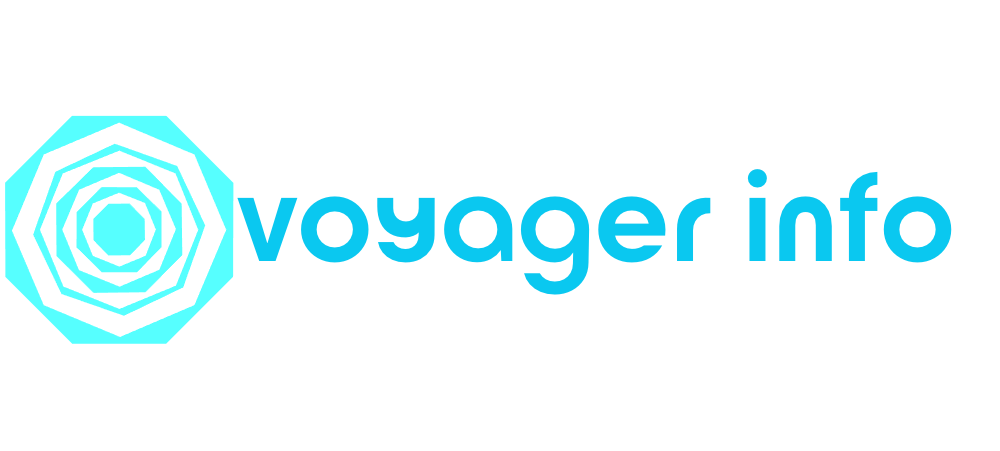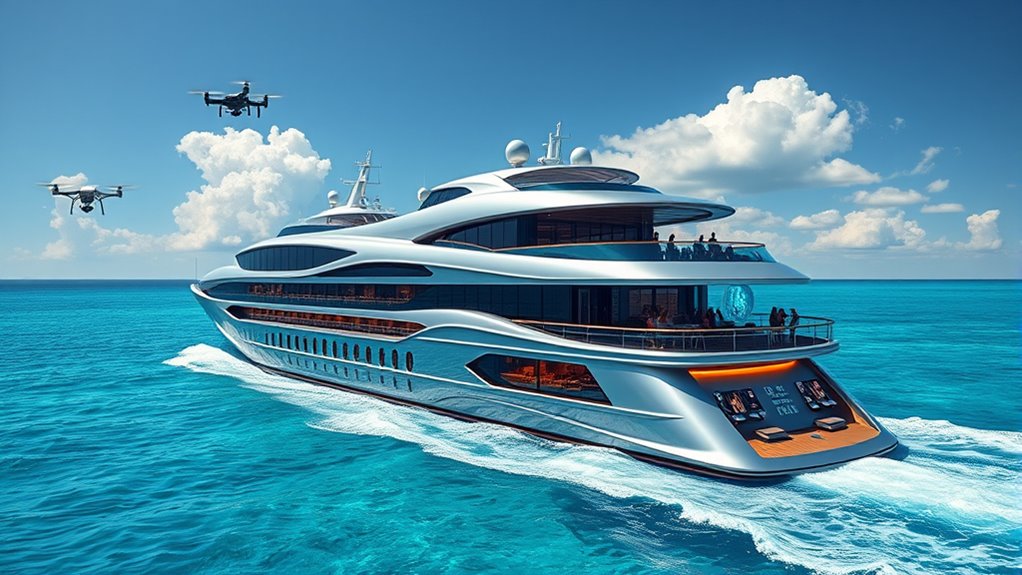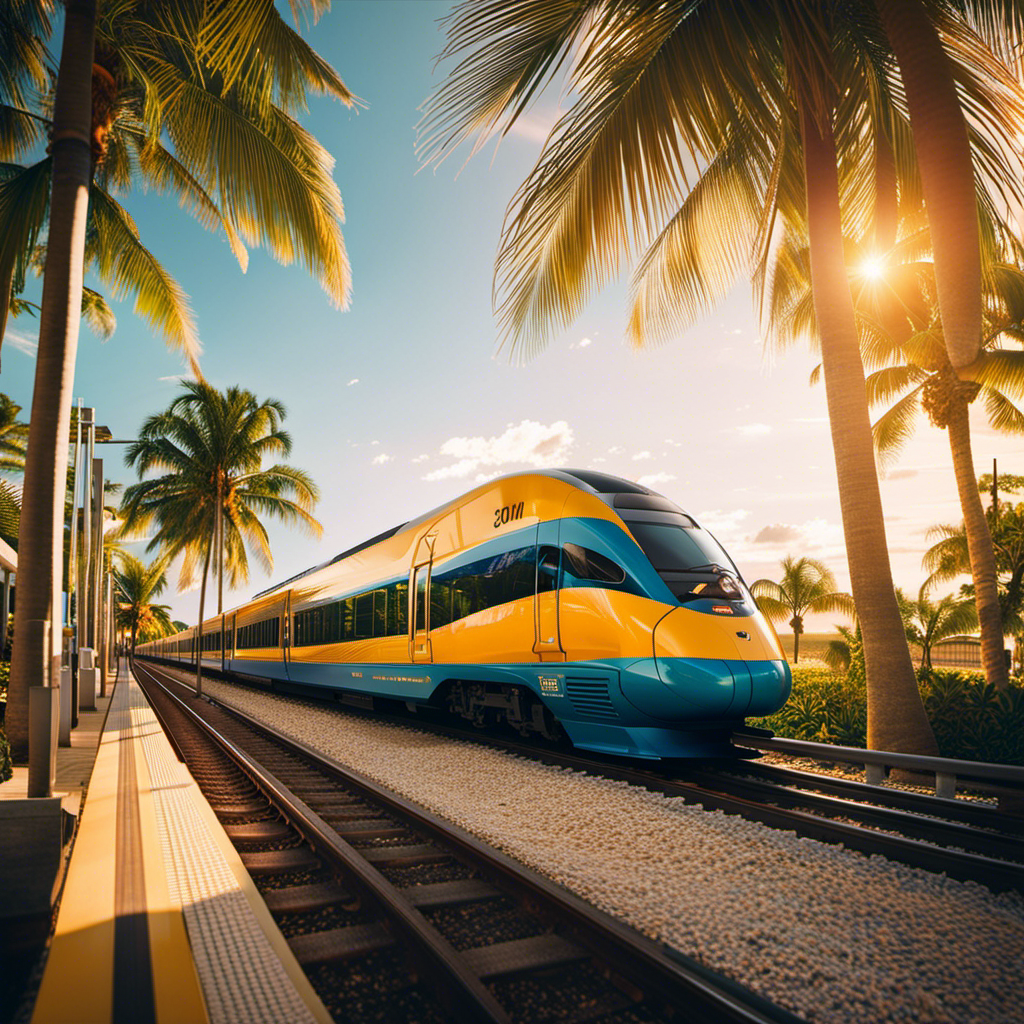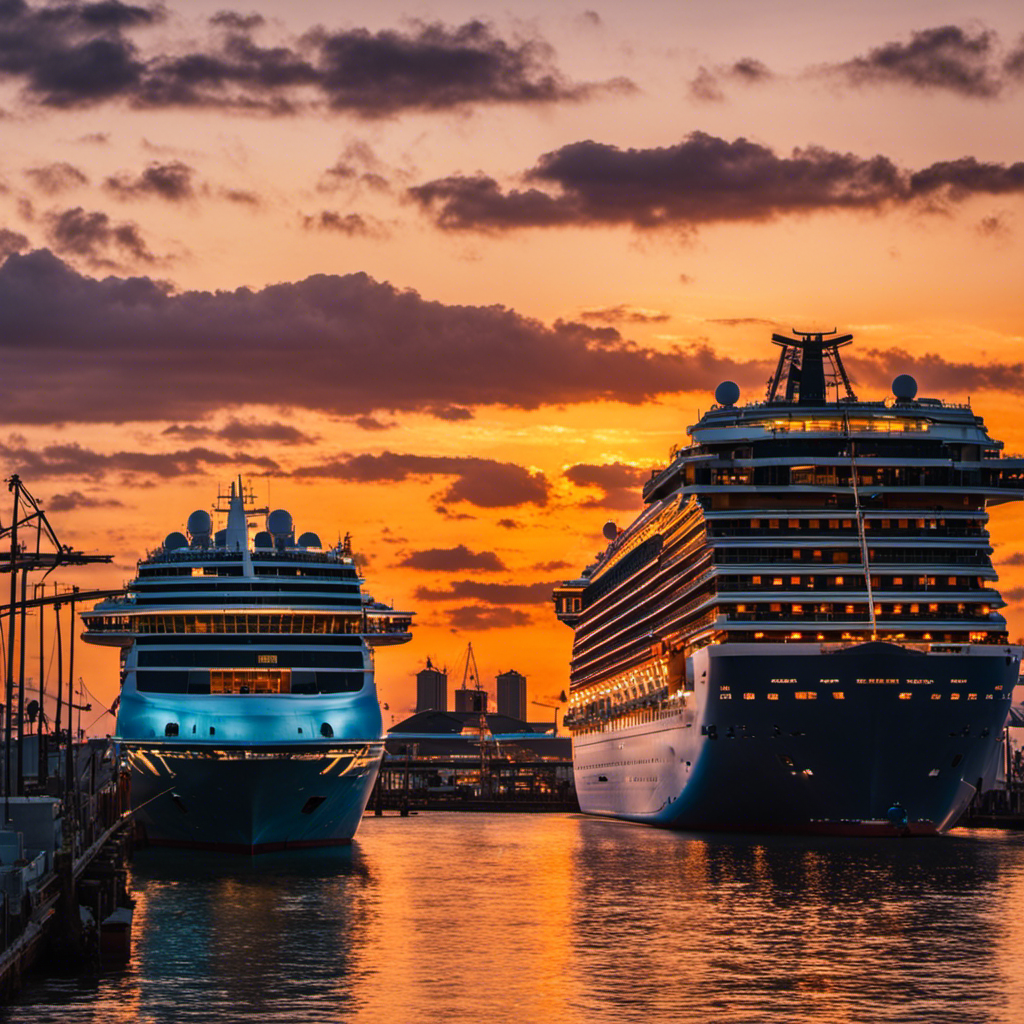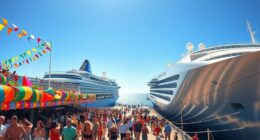Technology is transforming cruises by making your experience more personalized, eco-friendly, and seamless. You can enjoy AI-driven activity suggestions, wearables for contactless access, and faster internet like Starlink for reliable connectivity. Smart ports and digital systems reduce wait times and improve safety, while innovations in ship design boost efficiency and sustainability. If you keep exploring, you’ll discover how these advancements continue to redefine what a cruise can be for you.
Key Takeaways
- Advanced satellite internet like Starlink provides high-speed, reliable connectivity onboard, enhancing communication and entertainment.
- AI and wearables enable personalized passenger experiences, seamless access, and efficient activity planning.
- Environmental technologies such as LNG fuel and shore power significantly reduce emissions and promote sustainability.
- Contactless digital systems streamline services, payments, and safety procedures, improving convenience and health standards.
- Industry collaboration drives innovation, integrating smart ports and predictive maintenance for safer, greener cruises.
Advancements in Eco-Friendly Technologies and Sustainability

Advancements in eco-friendly technologies are transforming the cruise industry by making ships more sustainable and less polluting. One major change is the adoption of LNG fuel, which cuts sulfur oxide emissions by 99% and reduces carbon dioxide emissions by 20-30%. Major cruise lines, like TUI Cruises and Carnival, are launching LNG-powered vessels to improve energy efficiency. LNG acts as a transitional fuel, helping ships lower their environmental impact while moving toward full decarbonization. Additionally, shore power connects ships to local grids at ports, enabling engine shutdown and reducing emissions by up to 80%. Nearly half of the global fleet is equipped for shore power, with regulations like Seattle’s requiring its use by 2027. These innovations greatly reduce pollution and support sustainable cruising. Proper insulation and ground loop optimization are critical for maximizing energy efficiency in related fields. Incorporating energy-efficient systems is essential for further reducing the environmental footprint of modern ships. Moreover, the integration of green propulsion technologies is anticipated to play a significant role in shaping future sustainable maritime transportation, especially as innovations in renewable energy continue to evolve and become more accessible. As the industry advances, the development of sustainable materials will also be crucial in minimizing waste and environmental impact.
Personalization Through Artificial Intelligence and Wearable Devices

Imagine your cruise experience tailored precisely to your preferences, thanks to AI-driven activity planning and wearable devices. These technologies analyze your behavior and interests to recommend activities and offer personalized services in real-time. As a result, your journey becomes more engaging, seamless, and uniquely yours. Incorporating predictive modeling allows the system to forecast your needs and preferences more accurately, further enhancing your personalized experience. Additionally, leveraging user feedback helps refine recommendations over time to better suit individual tastes. Understanding retail hours and service availability can also optimize your experience during shore excursions and onboard activities. Recognizing emotional cues through wearable technology can further personalize interactions, creating a more empathetic and responsive environment throughout your cruise. Staying updated on industry trends also ensures that your cruise experience remains innovative and tailored to evolving technologies.
AI-Driven Activity Planning
Artificial intelligence is transforming how cruise lines personalize activities for passengers by analyzing their preferences and behaviors. This technology enables tailored experiences, suggesting activities based on your demographics and travel history. AI provides real-time recommendations for dining, entertainment, and excursions, ensuring your onboard experience matches your interests. It considers whether you prefer cultural, adventurous, or culinary pursuits, curating personalized itineraries. Additionally, AI can assist with divorce planning or other complex decisions during your trip by offering insights tailored to your specific situation. Leveraging AI analytics tools, cruise lines can continuously refine their offerings to better suit passenger needs. Incorporating home decor themes and preferences into the planning process can further enhance the personalization experience, making each journey uniquely suited to individual tastes. The use of wearable devices allows for even more precise tracking of passenger preferences and real-time adjustments to activities, heightening the overall personalization. These advancements in personalization technology are helping create more memorable and satisfying journeys for travelers.
Wearables Enhance Engagement
Wearable devices are revolutionizing how cruise lines personalize your experience on board. With RFID wristbands serving as digital keys, you can effortlessly unbolt your staterooms and make payments without carrying cash or cards. Originally introduced for contact tracing during COVID-19, these wearables now offer advanced features like location tracking and personalized interactions, boosting your engagement. They’re integrated with ship systems to streamline access, booking excursions, and managing onboard services. Major cruise lines, such as Princess Cruises and MSC Cruises, have adopted mandatory wearables to enhance guest experiences. Smart cabin integration allows you to control lighting and climate, while biometric options like facial recognition speed up boarding. These innovations collect data to tailor activities and services, making your cruise more seamless, personalized, and enjoyable.
Enhanced Connectivity and Seamless Communication at Sea

Enhanced connectivity at sea is transforming how you stay linked during your cruise, thanks to advancements like satellite internet, contactless interaction tech, and digital navigation systems. These innovations guarantee faster, more reliable communication even in remote areas. As technology keeps evolving, you’ll experience seamless interactions that make your journey more enjoyable and efficient. Security zone info also highlights the importance of reliable systems for safety and peace of mind while traveling. Additionally, the integration of reliable communication systems ensures continuous connectivity, reducing disruptions during your voyage. Furthermore, improving environmental considerations helps promote sustainable and eco-friendly travel experiences at sea. Modern Porsche Tuning technologies, such as advanced engine management modules, serve as a reminder of how innovative solutions can optimize performance and efficiency, similar to what is now being achieved in maritime connectivity. Implementing self-watering plant pots in onboard gardens exemplifies how sustainable and efficient practices are increasingly integrated into modern cruise amenities.
Satellite Internet Advancements
Advancements in satellite internet technology are revolutionizing connectivity at sea, making it possible for cruise passengers to stay connected almost everywhere on their journey. The deployment of Starlink’s satellite network, with nearly 6,799 satellites and plans for 12,000, provides faster, more reliable internet than traditional systems. Oceania Cruises has already installed Starlink fleet-wide, offering unlimited high-speed WiFi included in fares. This technology supports streaming, video calls, and large file transfers, reducing latency and improving bandwidth. Low Earth orbit satellites withstand harsh maritime conditions, ensuring consistent connections even in remote ocean areas. These improvements boost guest satisfaction, enable remote work, and support essential ship operations. As Starlink expands, expect even greater speeds, stability, and coverage, transforming your onboard experience. Satellite internet advancements are also making it possible for ships to better handle data traffic, improving overall network performance. Additionally, the ongoing technological improvements are expected to further enhance connectivity quality and reliability at sea. Moreover, the use of advanced satellite technology helps minimize disruptions caused by weather or other environmental factors, providing a more dependable service. Furthermore, emerging innovations in satellite technology are anticipated to deliver even faster data transfer rates and enhanced coverage, pushing the boundaries of maritime connectivity.
Contactless Interaction Technologies
As satellite internet continues to improve onboard connectivity, cruise lines are increasingly focusing on contactless interaction technologies to enhance guest experiences and safety. Innovations like the OceanMedallion allow touchless interactions, enabling you to access services, make payments, and navigate the ship effortlessly. Post-COVID, these systems have been upgraded to meet health standards, reducing physical contact and supporting social distancing. The OceanMedallion app integrates with wearable devices, letting you order food, plan activities, and manage your itinerary digitally. Contactless payment options via digital wallets streamline transactions, while safety tools like Royal Caribbean’s eMuster minimize gathering during drills. These technologies not only boost convenience and personalization but also reinforce safety, making your cruise more enjoyable and resilient to future health challenges.
Digital Navigation Systems
Digital navigation systems are transforming how ships operate at sea by integrating satellite technology, GPS, and artificial intelligence to optimize routes and improve safety. You get real-time data on weather, hazards, and nearby vessels, allowing for smarter decision-making. These systems help reduce fuel consumption by identifying the most efficient routes, saving costs and emissions. Advanced radar and sonar enable ships to detect obstacles and take evasive action in tricky environments. Enhanced connectivity through IoT integration improves communication between ships and shore, streamlining operations and safety monitoring. Passengers benefit from seamless communication, real-time updates, and personalized services, making their experience more enjoyable. Overall, digital navigation systems boost safety, efficiency, and passenger satisfaction, revolutionizing maritime travel through smarter, safer, and more connected ships.
Smart Ports and Infrastructure for Better Guest Transitions
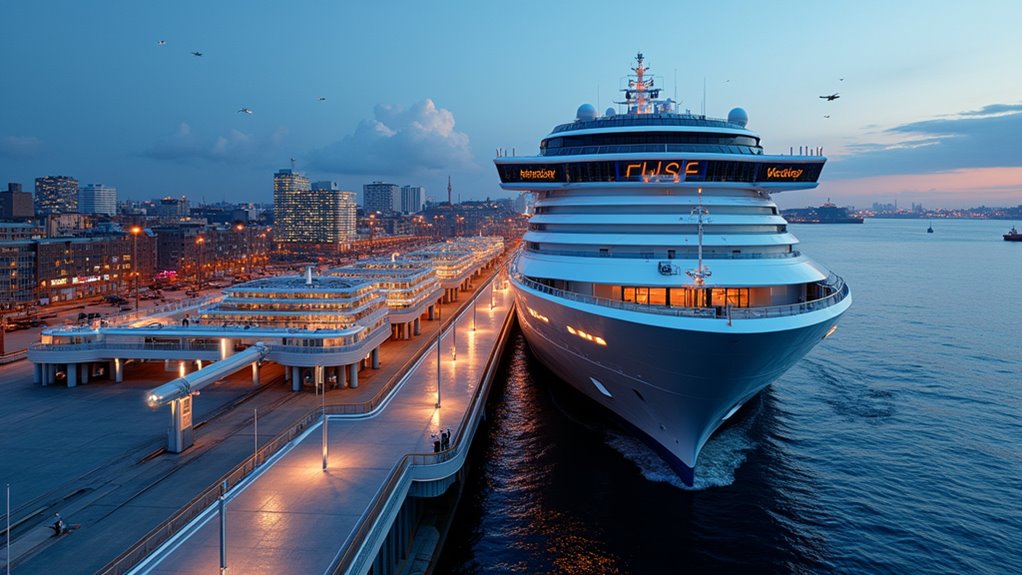
Smart ports are transforming the way cruise guests experience shifts by streamlining processes and reducing wait times. With advanced technology like IoT, AI, and big data, ports operate more efficiently, leading to quicker embarkation and disembarkation. These upgrades mean less waiting and smoother transitions, boosting your overall cruise experience. As investments grow, ports focus on predictive maintenance, environmental sustainability, and real-time updates, all designed to enhance guest safety and satisfaction. However, implementing these systems can be costly and complex, requiring infrastructure updates and staff training. Despite challenges like cybersecurity risks, the future of smart ports promises even smarter, more connected ports that prioritize seamless guest transitions.
- Faster processing with automation
- Real-time updates for passengers
- Enhanced safety through advanced surveillance
Innovations in Luxury Offerings and High-End Experiences
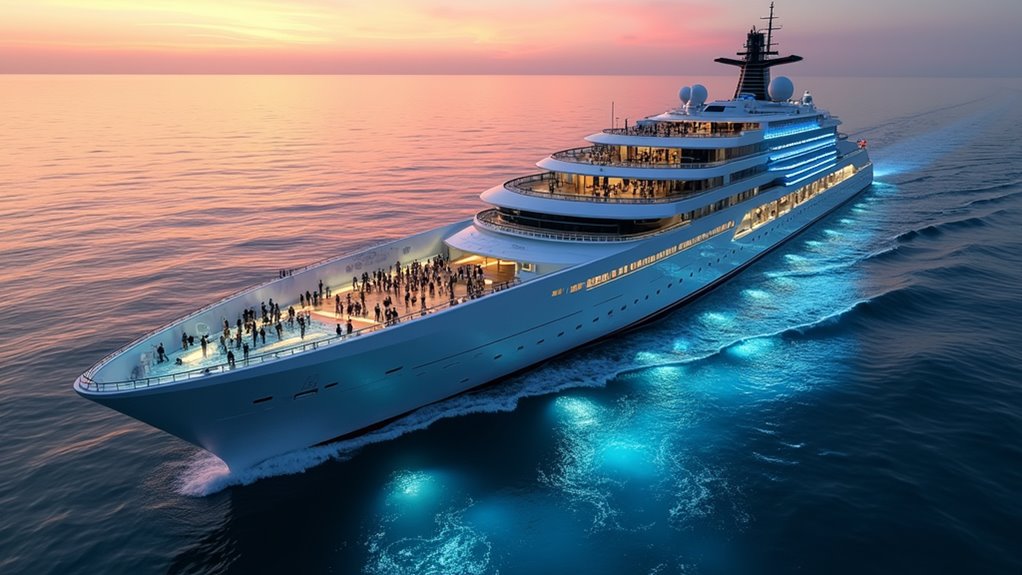
Innovations in luxury offerings are transforming the onboard experience by integrating cutting-edge technology and personalized services. You’ll find smart staterooms with IoT features that let you control lighting, temperature, and entertainment via voice or mobile apps. AI-driven guest services suggest activities and dining options tailored to your preferences, making every moment feel customized. High-tech entertainment, including virtual reality and LED-enhanced performances, immerses you in new ways to enjoy your time onboard. Culinary experiences expand with diverse dining options, like the first Eataly at sea, offering gourmet choices. Interactive digital activities, such as scavenger hunts and escape rooms, add fun and engagement. These innovations create a seamless, luxurious environment that elevates your cruise experience to new heights through technology-driven personalization.
Operational Efficiency and Resource Optimization

Operational efficiency and resource optimization are vital for making cruise ships more sustainable and cost-effective. By leveraging advanced technologies, you can streamline operations, reduce waste, and cut costs. AI-driven maintenance schedules keep ships running smoothly, minimizing downtime and maintenance expenses. Data analytics predict potential issues before they occur, allowing for proactive solutions. Smart systems integrate various operations, improving resource allocation and reducing manual errors. Additionally, energy-saving technologies like hull coatings and air lubrication cut fuel consumption by nearly 10%. Water conservation methods generate up to 90% of onboard water, reducing external usage. Waste management systems minimize environmental impact, while alternative fuels like LNG and biofuels lower carbon emissions. These strategies collectively enhance efficiency, supporting sustainability goals and operational performance.
- AI-driven maintenance and predictive analytics
- Energy-efficient technologies and water conservation
- Waste management and alternative fuel use
Future-Forward Ship Designs and Emerging Technologies
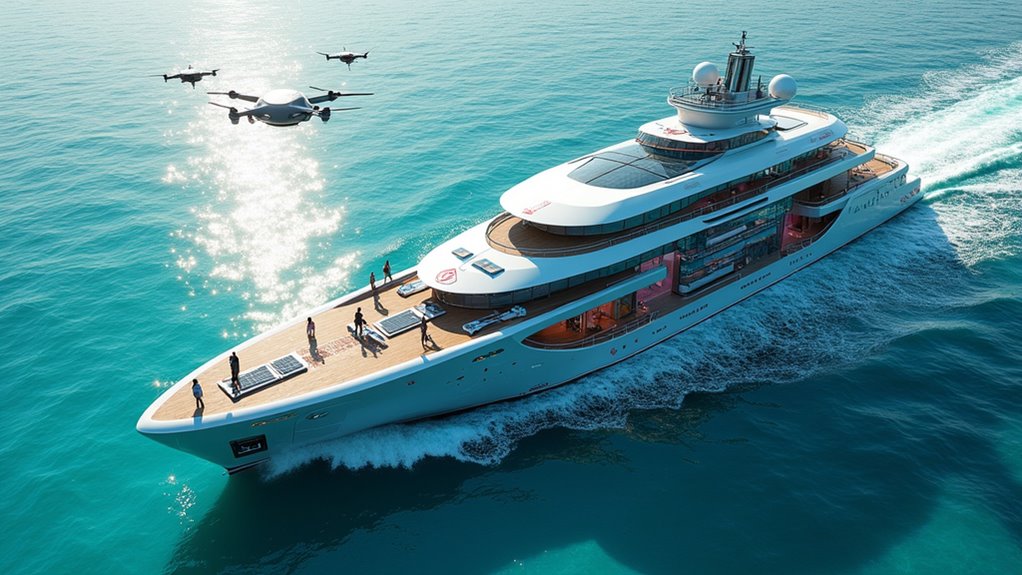
Future-forward ship designs are transforming the cruise industry by prioritizing sustainability, passenger comfort, and versatility. You’ll notice innovative layouts like Celebrity Xcel’s outward-facing designs that boost ocean views. Ships now use sustainable materials to lessen environmental impact and feature expansive outdoor spaces, like Silver Ray’s decks. Advanced cabins with high-tech amenities and modular construction allow easy updates for future needs. Emerging technologies further enhance your experience, with AI-powered attendants, virtual assistants, and voice-controlled cabins making interactions seamless. Some ships use facial recognition to speed check-ins, while cleaner fuels like LNG and hydrogen reduce emissions. These innovations create eco-friendly, personalized, and safer cruises, shaping a future where technology and sustainability go hand in hand.
| Feature | Benefit |
|---|---|
| Outward-facing layouts | Better ocean views and experience |
| Eco-friendly materials | Reduced environmental impact |
| Modular design | Easy updates and customization |
| AI and smart tech | Personalized, seamless onboard service |
Strategic Collaborations and Industry Partnerships

Strategic collaborations are reshaping the cruise industry by bringing together leading companies to develop advanced technologies and improve efficiency. These partnerships focus on integrating AI-driven solutions for maintenance, operational decision-making, and sustainability. For example, SpecTec Cruise and Seaquest Marine Technologies combined their platforms to enable condition-based and predictive maintenance, reducing costs and downtime. Industry events like Seatrade 2025 showcase these collaborations, highlighting innovations and setting new standards. These partnerships aim to leverage AI and analytics, transforming complex data into actionable insights, which enhances vessel performance and sustainability efforts. As a result, the industry benefits from improved efficiency, lower operational costs, and a stronger focus on eco-friendly practices.
- Integration of AI and predictive maintenance solutions
- Industry events fostering collaboration and innovation
- Focus on sustainability through technological partnerships
Frequently Asked Questions
How Do Cruise Ships Ensure Data Privacy With Advanced AI and Connectivity?
You should know that cruise ships protect your data by using secure storage systems and clear policies on AI data use. They guarantee transparency about how your information is collected and analyzed. Automated redaction helps keep sensitive data private, while robust cybersecurity measures defend against cyber threats. Additionally, cruise lines comply with legal standards like GDPR, so your personal info stays safe, and your privacy remains a top priority.
What Safety Measures Are in Place for Biometric and Facial Recognition Systems?
Think of biometric systems as your digital gatekeepers, ensuring safety on your cruise. They verify your identity quickly at ports, matching your face or fingerprint against secure databases. You can opt out if you prefer manual checks. These systems prioritize your privacy by deleting data after the trip, and cruise lines follow strict laws. With enhanced security and transparency, they aim to keep your voyage safe and smooth.
How Do Emerging Technologies Impact Cruise Ship Maintenance and Repair?
Emerging technologies revolutionize cruise ship maintenance and repair by making processes more efficient and cost-effective. You can use digital twin technology to monitor ships in real time, predict failures, and plan maintenance proactively. Drones and robotics inspect hulls quickly and safely, reducing downtime. AI-driven analytics optimize schedules and resource use, extending vessel lifespan and lowering costs. These innovations guarantee smoother operations and help you stay ahead in the competitive cruise industry.
What Training Is Provided to Staff for New High-Tech Guest Service Tools?
Imagine your staff as skilled navigators, charting a course through a sea of high-tech tools. They’re trained to harness digital platforms for seamless guest interactions, personalize experiences based on preferences, and use real-time communication to respond swiftly. With hands-on lessons in mobile solutions, data analysis, and integrated systems, your crew becomes adept at delivering smooth, customized service—making every guest feel like they’re on a voyage tailored just for them.
How Are New Technologies Tested for Environmental Compliance Before Implementation?
You test new technologies for environmental compliance through detailed assessments, ensuring they meet strict regulations like those from the EPA and Coast Guard. You conduct regular inspections and audits, verifying their effectiveness in reducing emissions and managing waste. Advanced monitoring tools track compliance in real-time, while impact assessments evaluate potential effects on marine life. If issues arise, swift corrective actions are taken to keep your operations environmentally responsible and aligned with evolving standards.
Conclusion
As you explore how technology transforms cruises, it’s clear that innovation often arrives when you least expect it—like discovering a new favorite feature on your ship. From eco-friendly tech to personalized experiences, these advancements make each voyage more seamless and memorable. So, next time you set sail, remember that behind the scenes, cutting-edge breakthroughs are quietly shaping your journey, proving that sometimes, the future of cruising feels just like a delightful coincidence you never saw coming.
